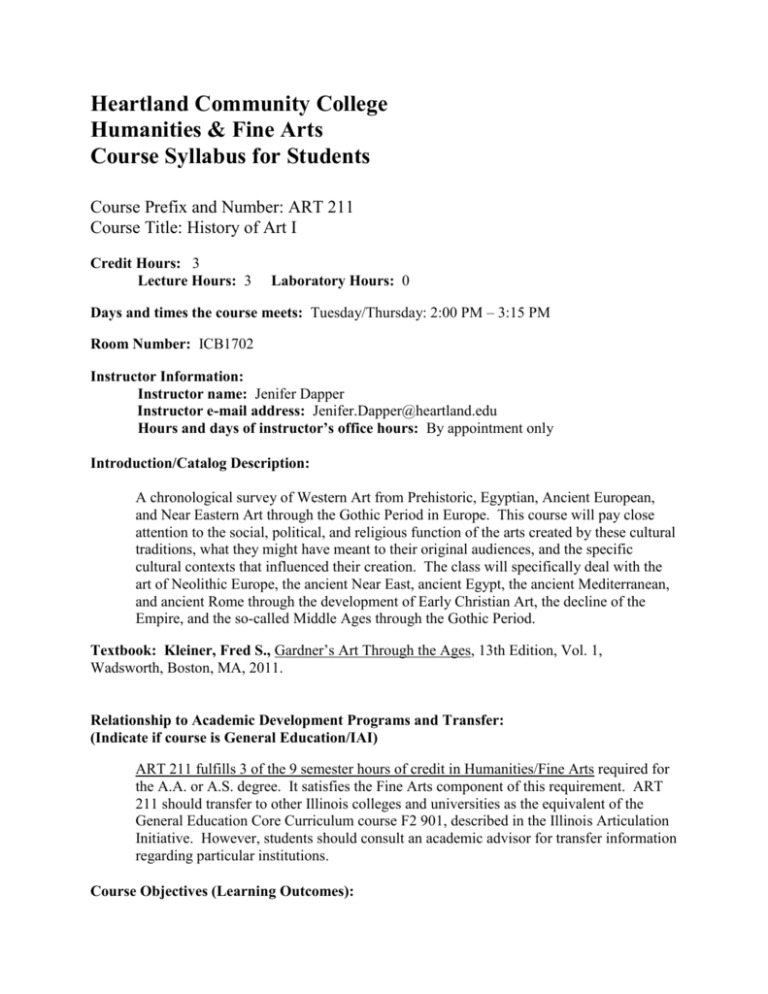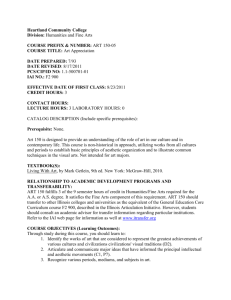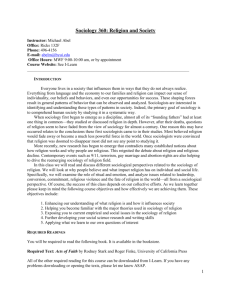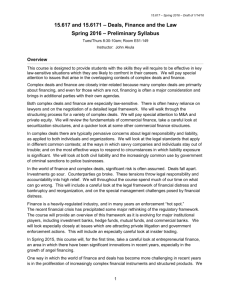ART 211 Dapper - Heartland Community College
advertisement

Heartland Community College Humanities & Fine Arts Course Syllabus for Students Course Prefix and Number: ART 211 Course Title: History of Art I Credit Hours: 3 Lecture Hours: 3 Laboratory Hours: 0 Days and times the course meets: Tuesday/Thursday: 2:00 PM – 3:15 PM Room Number: ICB1702 Instructor Information: Instructor name: Jenifer Dapper Instructor e-mail address: Jenifer.Dapper@heartland.edu Hours and days of instructor’s office hours: By appointment only Introduction/Catalog Description: A chronological survey of Western Art from Prehistoric, Egyptian, Ancient European, and Near Eastern Art through the Gothic Period in Europe. This course will pay close attention to the social, political, and religious function of the arts created by these cultural traditions, what they might have meant to their original audiences, and the specific cultural contexts that influenced their creation. The class will specifically deal with the art of Neolithic Europe, the ancient Near East, ancient Egypt, the ancient Mediterranean, and ancient Rome through the development of Early Christian Art, the decline of the Empire, and the so-called Middle Ages through the Gothic Period. Textbook: Kleiner, Fred S., Gardner’s Art Through the Ages, 13th Edition, Vol. 1, Wadsworth, Boston, MA, 2011. Relationship to Academic Development Programs and Transfer: (Indicate if course is General Education/IAI) ART 211 fulfills 3 of the 9 semester hours of credit in Humanities/Fine Arts required for the A.A. or A.S. degree. It satisfies the Fine Arts component of this requirement. ART 211 should transfer to other Illinois colleges and universities as the equivalent of the General Education Core Curriculum course F2 901, described in the Illinois Articulation Initiative. However, students should consult an academic advisor for transfer information regarding particular institutions. Course Objectives (Learning Outcomes): Through your study during this course you should learn to 1. Develop a solid foundation of vocabulary and grammatical skills for writing and speaking about art. 2. Demonstrate familiarity with ancient and artistic cultural patterns and stylistic traditions, and their continued relevance in the modern world. 3. Understand the complex relationship that exists between the visual arts and religion, mythology, and the social and political context of a particular place and time period. 4. Discuss and remain aware of the relationship between art history and other disciplines such as anthropology, archaeology, philosophy, theology, etc... 5. Participate in formal and critical analyses of aesthetic objects and art forms. 6. Demonstrate an understanding of written art history and art criticism. 7. Show visual recognition of the characteristics of art and architecture indicating the cultural unit from which the example and other associate works originate. Course Policies: Method of Evaluation (Tests/Exams, Grading System): Grading Policy: Exams Papers Vocabulary Lists Attendance Extra Credit 150 (4 @ 50 pts/ea.—lowest score dropped) 100 (2 @ 50 pts/ea.) 150 (15 pts/ea. @ 1/unit @ 10 units) Pass/Fail (See policy details below) 20 (See policy details below) Total 400 A B C D F 90 - 100% 80 - 89% 70 - 79% 60 - 69% 00 - 59% Exams: There will be four exams in this course, each worth 50 points. The lowest of these four grades will be dropped for a total of 150 points. At the end of the semester, if you have taken the previous four exams and are happy with your grade for this portion of the class, you will not be required to take the fourth and final exam. The exams will be primarily composed of short slide comparison essays and multiple choice questions about important concepts and/or specific artworks. Short Papers: Two times during the semester, you will be required to write a short 4-6 page (typed, double spaced, 12 pt. font) paper that focuses on analyzing and/or comparing artworks in different contexts. Specific instructions will be discussed as each paper comes up. Each paper is worth 50 points, for a total of 100 points toward your final grade. Vocabulary Lists: Each time we start a new unit, I will pass out a Unit Outline handout containing a vocabulary list, the names of most of the artworks that we will look at in class. Most, if not all, of the material on these outlines will be covered in class, and ideally, I'd like them to act as a kind of note-taking guide for you during our lectures and discussions. They will also serve as crucial study guides for your exams. Once we have gone over all of the vocabulary in a particular unit, I will have you type up the terms and definitions and hand them in to me for a grade. These will be collected roughly once a week, though specific collection times may vary depending on the unit. You get points for turning them in and for having the definitions complete and correct. Each vocabulary list is worth 15 points for a total of 150 for the whole semester. No late assignments will be accepted! Attendance: Attendance is absolutely mandatory and will be taken at the beginning of each class. This class is heavily reliant on in-class material and interactions. All absences MUST be excused with me BEFORE the missed class. If an emergency arises, talk to as soon as possible after the fact, and we may be able to make an exception. Emergencies include things like deaths in the family, extended hospitalizations, etc., and must provable with written documentation. Vacations, getting arrested, sleeping in, etc. will not be excused. In all cases, it is my call as to what constitutes a true emergency. Every unexcused absence will result in the automatic lowering of a letter grade from your final grade. YOU HAVE ONE FREEBIE. That means that missing more than four classes is an automatic F. Extra Credit: Any time prior to the last day of class, any student may visit any credible art museum or gallery and write a two page (double-spaced) typed review of their experience there. Such a paper should discuss specific objects from the museum’s collection and/or special exhibit, and be accompanied by a pamphlet or program from the museum or hosting establishment, or a photograph of yourself at the venue. The successful completion of this option will result in a one-time 20 point increase of your final grade after all other grades have been figured. You may also use the extra credit assignment to cancel out an unexcused absence. Student Conduct (Courtesy): Courtesy is a prerequisite of any college course. Thus, I will not tolerate late arrivals or early exits from my class; doing so will result in ZERO points for that day’s assignments. I will also not tolerate cell phone rings, text messaging, repetitive noises, talking, sleeping, or any other general rudeness that could disrupt the learning processes of yourself and your fellow students. As your instructor, I reserve the right to dismiss you from an individual class or even the course as a whole if I feel your behavior is inappropriate or improper for a setting of higher education. Students with Disabilities: It is the student’s responsibility to contact the instructor in a timely manner to arrange for appropriate accommodations or special arrangements. Email Clause: Unless we've made some specific arrangement ahead of time, I don't want emailed papers. This is more for your benefit than mine, since I get a lot of emails daily in my faculty inbox, and it's easy for student papers to get lost in the shuffle. Hard copies only please. Academic Integrity and Plagiarism: Academic Integrity: Academic integrity is a fundamental principle of collegial life at Illinois Central College and is essential to the credibility of the College’s educational programs. Moreover, because grading may be competitive, students who misrepresent their academic work violate the right of their fellow students. The College, therefore, views any act of academic dishonest as a serious offense requiring disciplinary measures, including course failure, suspension, and even expulsion from the College. In addition, an act of academic dishonesty may have unforeseen effects far beyond any officially imposed penalties. Violations of academic integrity include, but are not limited to cheating, aiding or suborning cheating or other acts of academic dishonesty, plagiarism, misrepresentation of data, falsification of academic records or documents and unauthorized access to computerized academic or administrative records or systems. Definitions of these violations may be found in the college catalog. Plagiarism: Plagiarism is the presenting of others’ ideas as if they were your own. When you write a paper, create a project, do a presentation or create anything original, it is assumed that all the work, except for that which is attributed to another author or creator, is your own. Plagiarism is considered a serious academic offense and may take the following forms: 1 2 3 4 5 6 Copying word-for-word from another source and not giving that source credit. Paraphrasing the work of another and not giving that source credit. Adopting a particularly apt phrase as your own. Using an image or a copy of an image without crediting its source. Paraphrasing someone else’s line of thinking in the development of a topic as if it were your own. Receiving excessive help from a friend or elsewhere, or using another project as if it were your own. *Note that word-for-word copying is not the only form of plagiarism. The penalties for plagiarism may be severe, ranging from failure on the particular piece of work, failure in the course or expulsion from school in extreme cases. Course Outline: (May vary—all due dates are tentative until confirmed in class by the instructor) Week I Tues. 8/23: Syllabus, Course Objectives Thurs. 8/25 Introduction Chapter: What is Art History? Week II Tues 8/30: Chapter 1: Prehistoric Art Thurs. 9/1: Chapter 1: Prehistoric Art Week III Tues. 9/6. Chapter 2: Ancient Near East Thurs. 9/8: Chapter 2: Ancient Near East Week IV Tues. 9/13: Chapter 3: Ancient Egypt Thurs. 9/15: Chapters 3: Ancient Egypt Week V Tues. 9/20: Exam 1 (Chapters 1-3) Thurs. 9/22: Chapter 4: Ancient Agean Week VI Tues. 9/27: Chapter 4: Ancient Agean Thurs. 9/29: Chapter 5: Ancient Greece Week VII Tues. 10/4: Chapter 5: Ancient Greece Thurs. 10/6: Chapter 5: Ancient Greece Week VIII Tues. 10/11 Exam 2 (Chapters 4-5) Thurs. 10/13 Chapter 9: Ancient Rome Week IX Tues. 10/18: Chapter 9: Ancient Rome Thurs. 10/20: Chapter 10: Roman Empire Week X Tues. 10/25 Chapter 10 & 11: Roman Empire Thurs. 10/27: Chapter 11: Roman Empire Week XI Tues. 11/1: Exam 3 (Chapters 9-11) Essay 1 Due Thurs. 11/3: Chapter 12: Early Christian and Byzantine Art Week XII Tues. 11/8: Chapter 12: Early Christian and Byzantine Art Thurs. 11/10: Chapter 16: Early Medieval Art Week XIII Tues. 11/15: Chapter 16: Early Medieval Art Thurs. 11/17: Chapter 17: Romanesque Europe Week XIV Tues. 11/22: Chapter 17: Romanesque Europe Thurs. 11/24 NO CLASS - Thanksgiving Week XV Tues, 11/29: Chapter 18: Gothic Europe Thurs. 12/1: Chapter 18: Gothic Europe Week XVI Tues. 12/6: Chapter 19: Pre-Renaissance Italy Thurs. 12/8: Chapter 19: Pre-Renaissance Italy Essay 2 Due Week XVII FINAL EXAM 4 (Chapters 12, 16, 17, 18 & 19) TBA






